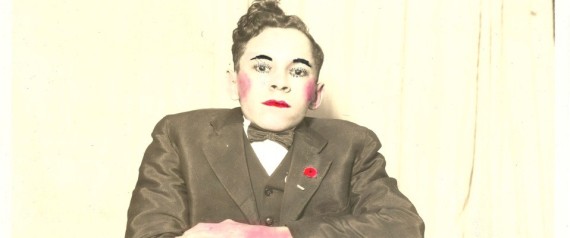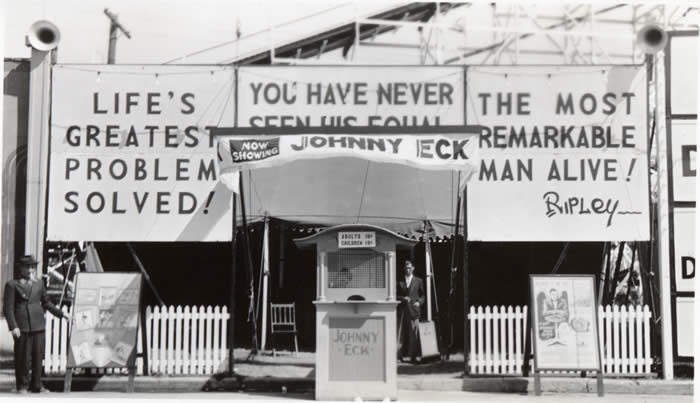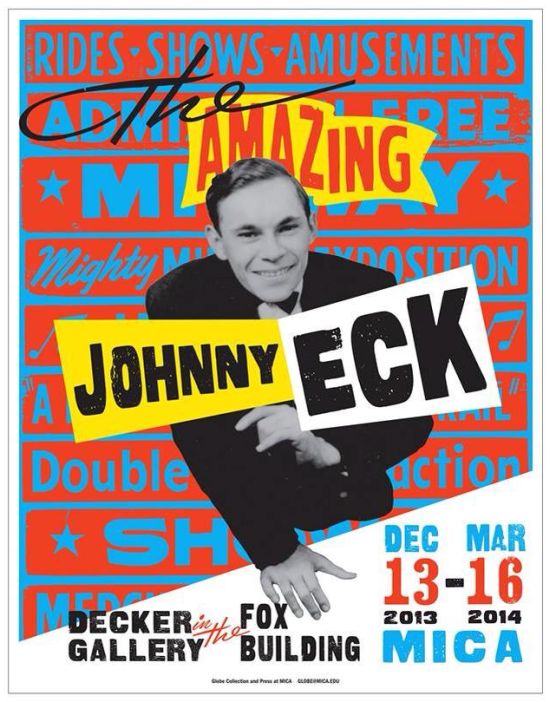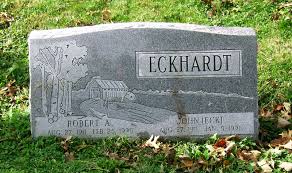By Tom Warner (Baltimore Or Less)
Johnny Eck – the legendary hometown “Half Man” sideshow performer, Hollywood actor (Tod Browning’s 1932 “Freaks“) and latter-day screen painter – will soon be the subject of an upcoming exhibition at the Maryland Institute College of Art. “The Amazing Johnny Eck,” curated by Johnny Eck Museum founder Jeffrey Pratt Gordon and featuring Eck’s screen paintings, scrapbooks, and other artifacts, runs from December 13, 2013 through March 16, 2014 and is billed as “the world’s largest” about this extraordinary man whom Robert Ripley once called “the most remarkable man alive.”
“I’ve spent nearly two decades trying to understand the far-reaching arms of Johnny Eck. He touched so many people during his life and continues to do so decades after his passing. My motivation has always been to share his life with others through his personal letters, photographs, artwork and objects that helped define his multifaceted life.”
– Jeffrey Pratt Gordon, Johnny Eck Museum founder (quoted by VanishLive.com, “News, Articles and Reviews for Magicians”)
According to MICA’s press release, “The Amazing Johnny Eck” will coincide with a second exhibition at MICA celebrating Baltimore culture: “PICTURE WINDOWS … The Painted Screens of Baltimore and Beyond.” From Friday, Dec. 13, 2013–Sunday, March 16, 2014, the Fox Building’s Meyerhoff Gallery (1303 W. Mount Royal Ave.) will house this exhibition that explores the history and cultural significance of the artistic painted screens throughout the city, beginning 100 years ago. (As a young man, Eck was a student of Baltimore’s original screen painter, William Oktavec, and when he returned from his film career in Hollywood, he picked up where he left off, painting screens for his neighbors and far-flung customers and admirers.) MICA also plans to screen the film Freaks in conjunction with a panel discussion and a circus performance. More details will become available closer to the exhibition opening.
Watch “Johnny Eck – Freaks Extra” (YouTube).
Johnny Eck is buried, alongside his brother Robert, at Green Mount Cemetery, 1505 Greenmount Avenue. They are located in Lot 19 of Section R under their original family name “Eckhardt.”
See also:
Click Right Here, Folks, For The World’s Largest Exhibition About ‘King Of The Freaks’ Johnny Eck
By Arin Greenwood (Huffington Post, 11/13/2013)
Johnny Eck once walked to the top of the Washington Monument on his hands. He couldn’t have done it any other way; he had no legs.
Eck was born in Baltimore in 1911, healthy despite missing the lower half of his body. In 1923 or 1924 — accounts vary — he and his twin brother Robert, who was fully developed, were plucked from the audience of a magic show to leave school and join the circus-world themselves.
The plucker, described as “an unsavory manager” who “would plague him for years” in Eck’s 1991 Baltimore Sun obituary, nonetheless set the so-called “King of the Freaks” on an irreplicable life path:
“I was a performer, walked a tight rope, worked on trapeze, juggled — I did everything,” Eck recalled in the book, “America’s Forgotten Folk Arts.”Eck relished life among society’s fringe elements.
“I met hundreds and thousands of people, and none finer than the midgets and the Siamese twins and the caterpillar man and the bearded woman and the human seal with the little flippers for hands. I never asked them any embarrassing questions and they never asked me, and God, it was a great adventure,” he told a Baltimore Sun columnist in 1979.
Eck’s appearances at the 1931 Canadian National Exhibition led FTC to a role in “Freaks,” Tod Browning’s controversial film about a loyal clan of deformed circus performers.
Later, Eck appeared briefly in two other Hollywood films and in a dramatic magic act in which he and a cooperative midget portrayed a man sawed in half.
At the end of his film career, Eck and his brother returned to Baltimore, where the two opened a penny arcade and started up a miniature train ride, among other enterprises. Johnny also became an accomplished screen painter (screen painting is a traditional Baltimore folk art; screen windows and doors are painted on the outside, to give residents more privacy).
Continue reading “Click Right Here, Folks…” at huffingtonpost.com.




